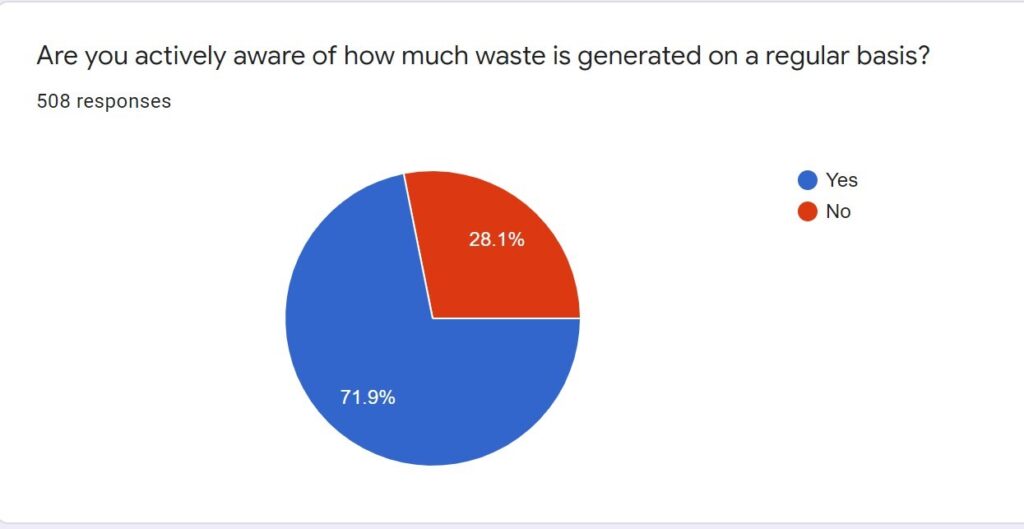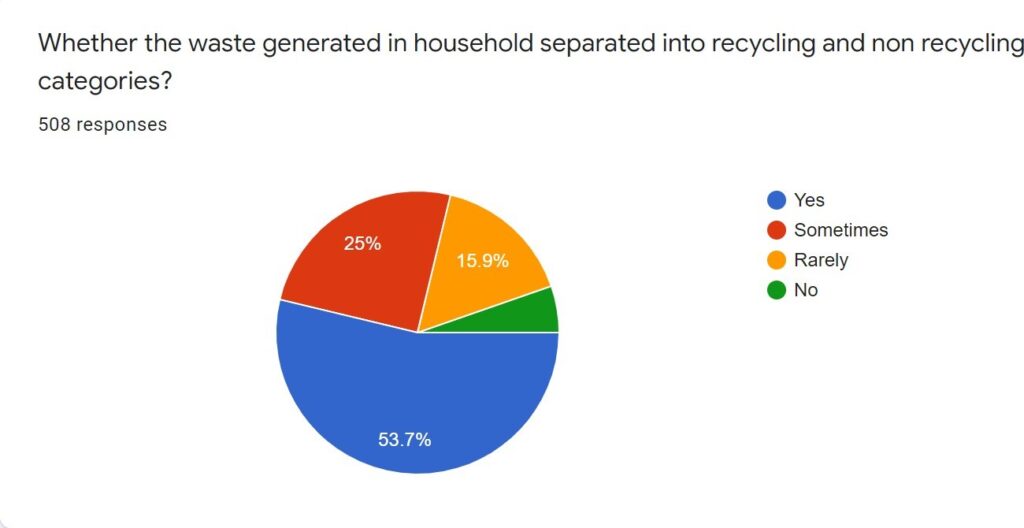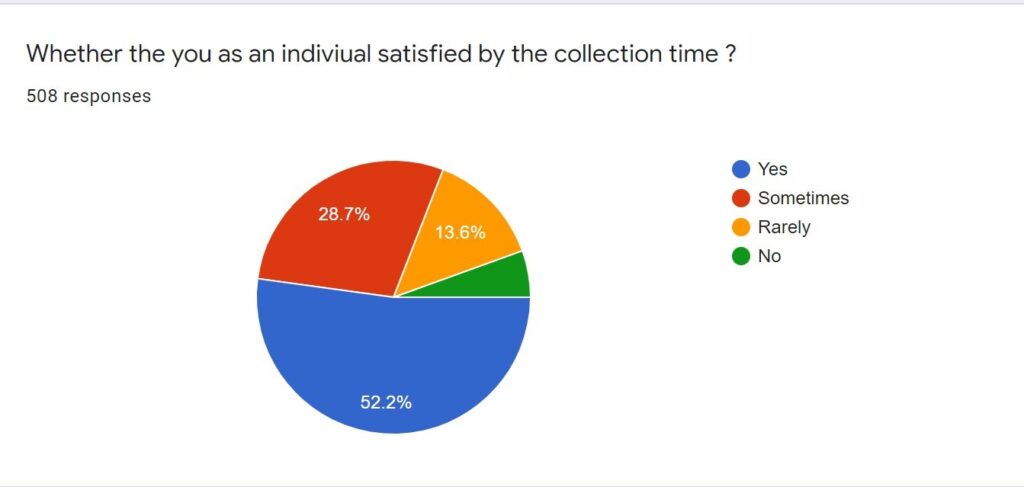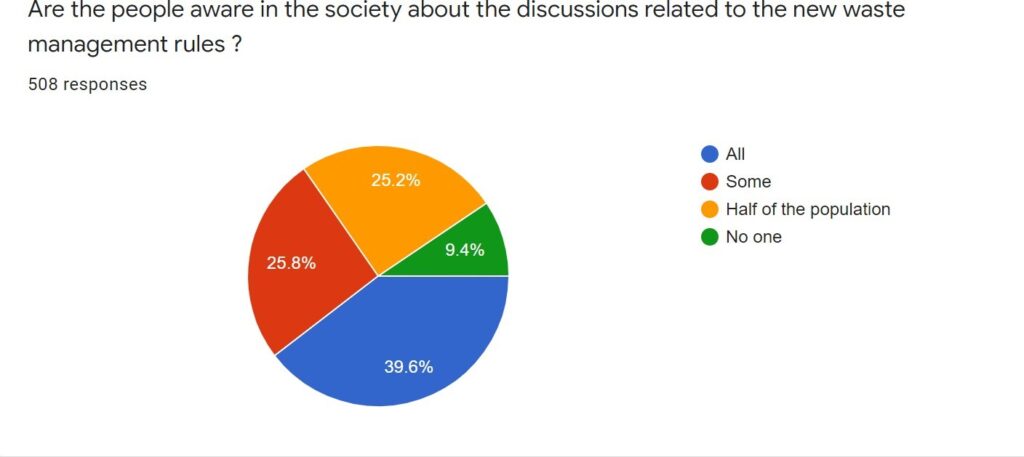Abstract
Plastic pollution is the accumulation of plastic objects and particles (e.g. plastic bottles, bags and microbeads) in the Earth’s environment that adversely affects wildlife, wildlife habitat, and humans. However, humans, due to sheer numbers and our modern, industrialized lifestyles, have created more plastic waste than nature can cope with and in some cases, we have completely devastated whole ecosystems. The intensity of plastic pollution along the coastal areas of India has been rising during the past decade that requires immediate action. Advocating for behavioral changes from society remains a daunting task that acknowledges their lifestyle. This research paper aimed to gain an understanding on the public perception towards waste management practices. Questionnaire was used to accurately capture and reflect the perceptions of people using current waste management techniques and the effect it has on environment. The results from the study showed that Indian people have a generally more negative perception towards single-use plastics; a high level of awareness towards their impacts on marine environment; and a strong willingness to reduce their consumption of single-use plastic. Based on the findings, recommendations emphasized the need to incentivize reusable plastic bags, promote awareness and advocacy pertaining to the environmental concerns of single-use plastics and further investigate the potential of a plastic ban in India. This research can contribute towards developing adequate, appropriate strategies to address the issues of single-use plastics and environmental conservation.
1. Introduction
Humans generate a lot of plastic waste, much of which now affects the air we breathe, the water we drink, and land on which we live. According to the Experts, about 11.2 billion tons of solid waste is collected worldwide, almost all of which comes from humans alone.
Waste management rules in India are based on the principles of “sustainable development”, “precaution” and “polluter pays”. These principles mandate municipalities and commercial establishments to act in an environmentally accountable and responsible manner—restoring balance, if their actions disrupt it. The key to efficient waste management is to ensure proper segregation of waste at source and to ensure that the waste goes through different streams of recycling and resource recovery.
1.1 Types of plastic waste
There are three major forms of plastic that contribute to plastic pollution: microplastics as well as mega- and macro-plastics. Mega- and micro plastics have accumulated in highest densities in the Northern Hemisphere, concentrated around urban centers and water fronts. Plastic can be found off the coast of some islands because of currents carrying the debris. Both mega- and macro-plastics are found in packaging, footwear, and other domestic items that have been washed off of ships or discarded in landfills. Fishing-related items are more likely to be found around remote islands. These may also be referred to as micro and macro debris.
Plastic debris is categorized as either primary or secondary. Primary plastics are in their original form when collected. Examples of these would be bottle caps, cigarette butts, and microbeads. Secondary plastics, on the other hand, account for smaller plastics that have resulted from the degradation of primary plastics.
1.2 Where does plastic end up
With rapid urbanization, India is facing massive plastic waste management challenge. Over 377 million urban people live in 7,935 towns and cities and generate 62 million tons of municipal solid waste per annum. Only 43 million tons (MT) of the waste is collected, 11.9 MT is treated and 31 MT is dumped in landfill sites. Solid Waste Management (SWM) is one among the basic essential services provided by municipal authorities in the country to keep urban centers clean.
However, almost all municipal authorities deposit solid waste at a dump yard within or outside the city haphazardly. Experts believe that India is following a flawed system of waste disposal and management.
2. Methodology
- Study Area
Mumbai is the capital city of the Indian state of Maharashtra. According to the United Nations, as of 2018, Mumbai is the second-most populous city in the country after Delhi and the seventh-most populous city in the world with a population of roughly 20 million. As per Indian government population census of 2011, Mumbai was the most populous city in India with an estimated city proper population of 12.5 million living under Municipal Corporation of Greater Mumbai. Mumbai is the center of the Mumbai Metropolitan Region, the sixth most populous metropolitan area in the world with a population of over 23 million.
The study was conducted in Bandra is an upscale coastal suburb located in Mumbai, India. The suburb is located to the immediate north of the Mithi River, which separates Bandra from Mumbai City district. It is the third-largest commercial hub in Maharashtra, after Mumbai & Pune, primarily aided by the Bandra Kurla Complex. A total of 508 participants were included in the sample. The sample population was chosen from various locations in Bandra. This was useful as it enabled to target different members of the population within the areas to gain better understanding of the complex perceptions held towards waste across demographic groups.
2.2. Data Collection
Data for this study was collected using a questionnaire as the main research instrument. Primary data was collected through the administration of questionnaires to the residents in Bandra to gain an understanding of their perceptions towards waste management practices. The questionnaire was the most suitable instrument to use because the information required was brief and uncontroversial. The research required standardized data and the questionnaire allowed respondents to quickly and easily understand the questions, which allowed for efficient data collection. At the beginning, the questionnaire instructions were given to the respondents including the purpose and description of the research. The respondents were able to receive assistance from the researcher if they had any questions or needed clarification on any of the questions. Even though the questionnaire was in English, explanations of the questions were given in their native languages, whenever necessary. To avoid the respondents losing interest and make them easily understandable, survey questions were formulated as brief as possible.
2.3. Sampling Strategy
Participants were chosen on a random basis using systematic sampling whereby every fifth person who walked past the researcher (in the relevant areas) were asked to participate in the survey. This thereby reduced the bias in the selection of participants for the study. The data collected in the survey was analyzed using the MS Excel 2019. This system allowed the researcher to analyses and transform raw data collected, to examine trends within the dataset. The findings were presented using graphs, pie charts and tables to illustrate the results of the data collection.
3. Results and Discussion
- Type of Household

There were total of 508 respondents participated in the questionnaire process resident in Bandra. All 508 respondents were Indian citizens. Information pertaining to the demographics of the sample population was collected to gain a clear understanding of the sample population characteristics. Most of the respondents are living alone or have a single household and are working as well which is around 50% of the respondents. Other majority are 40% that is the families with small children. Other lesser-known categories are family with no children and retired/senior citizens.
3.2 Awareness about waste generation as an individual

A critical component in any waste management program is public awareness and participation, in addition to appropriate legislation, strong technical support, and adequate funding. Waste is the result of human activities and everyone needs to have a proper understanding of waste management issues, without which the success of even the best conceived waste management plan becomes questionable. About 72% of the respondents are aware about waste generated by them and 28% are unaware of the waste generated in their household.
3.3 Separation of waste into recycling and nonrecycling categories

Waste segregation is included in law because it is much easier to recycle. Effective segregation of wastes means that less waste goes to landfill which makes it cheaper and better for people and the environment. It is
also important to segregate for public health. Only 54% of the respondents are aware of the practice to segregate waste into recycling and nonrecycling categories. There are only 25% who sometimes implement this practice and 16% rarely do the implementation.
3.4 Time taken for garbage collection by the Municipal authorities

Lesser time spent in garbage collection the better and efficiently the process is carried out by the municipal authorities. The faster collection time also leads to a better experience in waste disposal services for the respondents. About 52% of the respondents are satisfied by the garbage collection time taken in their locality. On the other hand, 28% are sometimes happy about this service and 14% are rarely satisfied regarding the service at hand.
3.5 Efficiency of the garbage collection services

Efficiency in garbage collection services includes whether the services were provided on a daily basis to the respondents. The effectiveness of the service also leads to less effort by the respondents to keep their surrounding environment neat and clean. About 53% of the respondents are satisfied by the garbage collection procedure followed in their locality. On the other hand, 23% are sometimes happy about the procedure and 17% are rarely satisfied by the current garbage disposal procedure followed in their societies.
3.6 Recycling Campaigns & Waste reduction organized


Recycling campaigns help in conserving natural resources, save energy and reduce demand for raw materials. It also helps us to create awareness about saving our wildlife and ecosystem. In 38% of the societies, recycling campaigns are never conducted and 28% of the societies conduct these campaigns sometimes . In regard to waste reduction campaigns, – 36% of the waste reduction campaigns are never conducted and 27% of the societies conduct the waste reduction campaign sometimes. This is a very low percentage which leads to low awareness among people about recycling waste mechanism and waste reduction campaigns as well
3.7 Knowledge about new waste management rules

Knowledge about environment cleanliness makes an individual aware about his duty towards the Mother Earth. Clean environment is green environment. It also lessens the chances of illness and diseases being spread through the air, reducing the risk of respiratory illnesses. Also, it ensures that toxic products are not being led into our waterways, which can pollute our water and stop us from having a clean water system. All 40% of the respondents need to increase their understanding of the rules about the new waste management rules for effective waste disposal and reduction. This calls for more advertising, campaigns and society discussions surrounding this topic so every person is aware about his rights.
3.8 Frequency of waste collection

Not only does following proper waste collection procedures help keep the
environment clean, but it also makes the community’s overall health standards better. With waste being properly disposed of, our environment is cleaner, meaning there are fewer health risks and hazards around to affect us. This includes not having our surroundings polluted and, instead, ensures that our society remains as healthy as possible. But only 33% of the respondents have daily waste collection practices while only 35% of respondents living in highly populated residential area consisting mostly of closely packed, decrepit housing units in a situation of deteriorated infrastructure faced the waste collection procedure only few times a week.
3.9 Did you know the true fact about municipal waste?

This question led to astonishment as 82% of the respondents when asked as they were completely unaware of the amount of municipal waste generated by them.
4. Conclusion and Recommendation
This research found there to be a generally more negative perception towards single-use plastics and a relatively high awareness of the environmental impacts caused by them. Strategies such as incentivizing the use of reusable bags, promoting education and awareness, implementing policies to execute a proper and far-reaching Initiatives like Swachh Bharat are required at the primary level itself. Recommendations are made in relation to the findings of this research paper. Many of the solutions are practical and could play a role in reducing the consumption of single-use plastic and additionally minimize the prevalence of waste dumping grounds in Mumbai. Focal areas include incentivizing the use of reusable shopping bags; utilizing popular media platforms to raise awareness of right waste disposal practices and promoting recycling culture. Efforts should be made to offer economic incentives to customers for using reusable shopping bags. Offering incentives might provoke a behavioral change in individuals that reduces the consumption of plastic products which generates maximum amount of waste.
Effective incentives may be in the form of offering loyalty points or discounts on total purchases when using reusable shopping bags in store. In addition, it is suggested that alternatives such as paper, cloth or any other substances to be used instead of plastics should be sold at a very reasonable price so that everyone could afford it. This could allow consumption practices to move away from a linear and towards circular model. Awareness raising pertaining to the environmental issues associated with waste generation should be through the most popular platforms identified in the study. Social media such as Facebook, Instagram, Twitter, Pinterest etc. can be used as channels to reach out public and give out the conservation news. Further, newspaper and radio/TV can also be used wisely to inform and draw attention to pertinent environmental issues. This research indicated a potentially strong support from community members in favor of discussion and campaigns regarding sustainable waste generation practices.
5. Introduction and Experience
I am a student of Post graduate course at Mumbai university and as well as a CA Finalist. My interests lie in updating myself with current scenarios by reading articles and posts about them. My goal it to help contribute to a sustainable environment for all life forms by my skill and knowledge. I had a wonderful experience through this opportunity provided to me by Tarumitra to contribute to research about plastic waste management in my surrounding area. It helped me to understand the opinions and difficulties people face in the basic task of plastic waste management. This survey made me aware as an individual of the common errors I did while disposing plastic waste. It also helped me understand that plastic pollution can only came to a stop by our own actions and decision to build a clean and plastic free environment for our future generations.
In addition, I also wish to thank the respondents who willingly participated in the questionnaire survey to help me cultivate better practices for plastic disposal and helping me create this wave of change to a clean and safe environment for all.

